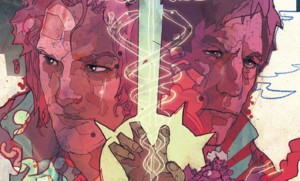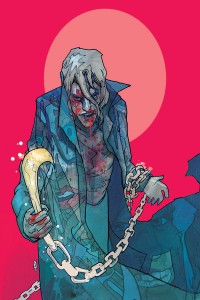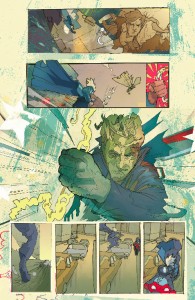![]() Olympus by Nathan Edmondson (writer) and Christian Ward (artist)
Olympus by Nathan Edmondson (writer) and Christian Ward (artist)
 I am starting to be very impressed with this writer whose books I’ve just started reading. Nathan Edmondson caught my eye first with Who Is Jake Ellis?, for which I wrote a positive review earlier this year. But today — May 15th, 2013, the day I’m writing this review — marks the release of a 50+ page first issue of a new limited series: Dream Merchant. I read it today and was absolutely blown away by both the writing and the art. It’s a six-issue story, so I should be writing a review of it before the end of the year. That issue made me want to pick up his earlier four-issue graphic novel* Olympus. I’m glad I did. I just finished reading it in one sitting, and I’m sure I’ll be rereading it again soon. It is so very different from Who Is Jake Ellis? and the follow-up Where Is Jake Ellis? that I’m starting to think this guy can work in any genre. I’ll be getting back to you on that since I’ve got a few other comics by him stacking up on my physical and virtual bookshelves, including an Iron Man title. While Who Is Jake Ellis? is a thriller of sorts, with a man on the run and lots of guns and technology that raises questions worthy of Philip K. Dick in Bladerunner, Olympus is a grand tale on the mythic level about two mortal brothers who can never die.
I am starting to be very impressed with this writer whose books I’ve just started reading. Nathan Edmondson caught my eye first with Who Is Jake Ellis?, for which I wrote a positive review earlier this year. But today — May 15th, 2013, the day I’m writing this review — marks the release of a 50+ page first issue of a new limited series: Dream Merchant. I read it today and was absolutely blown away by both the writing and the art. It’s a six-issue story, so I should be writing a review of it before the end of the year. That issue made me want to pick up his earlier four-issue graphic novel* Olympus. I’m glad I did. I just finished reading it in one sitting, and I’m sure I’ll be rereading it again soon. It is so very different from Who Is Jake Ellis? and the follow-up Where Is Jake Ellis? that I’m starting to think this guy can work in any genre. I’ll be getting back to you on that since I’ve got a few other comics by him stacking up on my physical and virtual bookshelves, including an Iron Man title. While Who Is Jake Ellis? is a thriller of sorts, with a man on the run and lots of guns and technology that raises questions worthy of Philip K. Dick in Bladerunner, Olympus is a grand tale on the mythic level about two mortal brothers who can never die.
 Yes, you read that correctly: Castor and Pollux are immortal mortals. Thus their function is crucial to the realms of both. Since they initially were born mortal, they walk among us, drinking our beer and romancing our women, but since they were granted immortality by Zeus 3,000 years before our time, they represent the will of the Gods. After they die by their own hands at midnight every New Year’s Eve, they are reborn every year as servants of Zeus who do the works of the Gods in a world that no longer believes in their existence.
Yes, you read that correctly: Castor and Pollux are immortal mortals. Thus their function is crucial to the realms of both. Since they initially were born mortal, they walk among us, drinking our beer and romancing our women, but since they were granted immortality by Zeus 3,000 years before our time, they represent the will of the Gods. After they die by their own hands at midnight every New Year’s Eve, they are reborn every year as servants of Zeus who do the works of the Gods in a world that no longer believes in their existence.
The book starts out with an excellent explanatory essay by Edmondson. I greatly appreciate his taking the time to give some background for and his thinking behind this great work. The comic book would be fine without it, but I think the essay, if seen as part of the story itself, helps the reader see the vast mythic canvas upon which Edmonson and Ward are working. Perhaps he could have conveyed this information in the comic book itself, but with four  issues, I don’t see how he would have been able to convey the scope of his project without losing his focus on the two brothers. Pushed into a four-issue story, that much information would have felt like an essay anyway. Better to just give it beforehand. The information is interesting in that it presents a particular perspective on myth and how and why our relationship with the gods has shifted. Reading this essay also reveals that Edmondson’s strength as a writer is his versatility — he is not solely a creative writer.
issues, I don’t see how he would have been able to convey the scope of his project without losing his focus on the two brothers. Pushed into a four-issue story, that much information would have felt like an essay anyway. Better to just give it beforehand. The information is interesting in that it presents a particular perspective on myth and how and why our relationship with the gods has shifted. Reading this essay also reveals that Edmondson’s strength as a writer is his versatility — he is not solely a creative writer.
As good as the essay is, I don’t mean to suggest that the comic completely relies upon it for the sense of the mythic. That mythic sense is conveyed in a variety of ways in the comic itself, the first of which is the art. I can’t imagine anyone picking up this comic and not immediately commenting on Christian Ward’s unique artwork. The world portrayed in the comic book often looks nothing like the world we inhabit. One gets the sense that Ward is helping us see our world through the eyes of the two brothers: We see the mythic penetrating through the mundane in every panel, both in the way the lines are often difficult to follow and through the magnificent colors from a palate apparently discovered for the purpose of creating this unique comic. This work of art is simply beautiful.
 The mythic sense of the comic is also conveyed by the elements seemingly added beyond that of the main storyline. But, when one steps back, the entire plot comes together in ways that are not clear until the end. For example, the first issue shows the brothers on what we are led to believe is typical of a routine yearly mission. We see them fulfilling their roles as they become the will of Zeus still active on Earth, if one had eyes to see, the eyes given us by Edmondson and Ward. This little story takes up the whole of the first issue and introduces in the final pages the next character whom the brothers will face next. However, the first job completed in issue #1 will have significance to the story in the final issue, revealing Edmondson’s ability to construct a tight plot without it feeling contrived. Issue #2 takes us 3,000 years into the past for a quick event that once again lets us see the brothers operating on a grand stage, in this case across time, eternally young, eternally strong, eternally daring.
The mythic sense of the comic is also conveyed by the elements seemingly added beyond that of the main storyline. But, when one steps back, the entire plot comes together in ways that are not clear until the end. For example, the first issue shows the brothers on what we are led to believe is typical of a routine yearly mission. We see them fulfilling their roles as they become the will of Zeus still active on Earth, if one had eyes to see, the eyes given us by Edmondson and Ward. This little story takes up the whole of the first issue and introduces in the final pages the next character whom the brothers will face next. However, the first job completed in issue #1 will have significance to the story in the final issue, revealing Edmondson’s ability to construct a tight plot without it feeling contrived. Issue #2 takes us 3,000 years into the past for a quick event that once again lets us see the brothers operating on a grand stage, in this case across time, eternally young, eternally strong, eternally daring.
These two brothers, finally, are what make this story work. Having a mythic tale focused on two key characters gives the reader something to focus on, something very tangible and recognizable so one doesn’t become lost in the larger myths being discussed or alluded to. These two brothers provide the anchor to the comic. If anything marks a similarity between the otherwise very different titles of Olympus and Who Is Jake Ellis?, it’s the banter back-and-forth between two men always together, helping each other out through thick and thin, with vastly different personalities. In Who Is Jake Ellis?, it’s between Jon and Jake Ellis. Jon is the only one who can see Jake, which leads the reader to question whether Jon is talking to himself or not. But even if he is, he maintains two very distinct  personalities, and he has very entertaining conversations with himself. In Olympus, we have a younger and older brother, and Edmondson makes clear the differences between the two and maintains those differences clearly throughout the comic. Those differences do affect the larger story, but they also make for some entertaining smaller scenes as well that give the story its humanity.
personalities, and he has very entertaining conversations with himself. In Olympus, we have a younger and older brother, and Edmondson makes clear the differences between the two and maintains those differences clearly throughout the comic. Those differences do affect the larger story, but they also make for some entertaining smaller scenes as well that give the story its humanity.
There is a larger story, a plot that pulls everything together, but I won’t discuss that here. I like to dance around the plot of a story in my reviews so as to not give away any spoilers, and I hope I have succeeded in conveying as much as I can get away with while giving away as little as possible! The main plot of the story requires the brothers to complete a serious task, and the stakes are high. Some characters — including some Gods — you will recognize as they make their way onto the stage of the comic, and in the end, as in all stories involving myth, all will be right again: Or will it? You’ll have to read Olympus to find out.
This book is almost perfect at fulfilling its purposes in a mere four issues. Perhaps my only complaint is that in some panels I have trouble figuring out what is happening no matter how much time I spend looking. A little ambiguity in the artwork is excellent for conveying that mythic sense I discussed above, but too much ambiguity just leaves me feeling confused a little more than seems good for the story. Based on the way this ambiguity decreases as the comic moves from issue to issue, I’m guessing that the artist worked to change that aspect of his style, perhaps for the very reasons I’m articulating. I can only guess. However, I think the risk the artist took in using such a style was well worth a few ambiguous, or less-than-perfect, panels. Why? Because of the artistic risk — when everything works and the colors combine with the style in just right manner — the effect is truly sublime, on the level of the artwork in Daytripper or some of the best art in Sandman.
Once again, it’s a pleasure for me to discover the work of Nathan Edmondson, just like it always is for a reader to discover a “new” author, or at least an author that is new to the reader. I’ll be keeping an eye out for his future work at the same time as I read his work that’s already out there. And I’ll be reporting back on those comics here at fanlit. Stay tuned. In the mean time, read the excellent Olympus.
*Graphic Novel: I think it’s useful to note the difference between a trade collection of an ongoing series, even if the trade collects a clear story arc, and a graphic novel that, like a prose novel, has a clear beginning and end as well as being a thematically unified whole. I use the term comic book as a broad umbrella term to cover trades, graphic novels, monthly issues, anthologies, etc.



I discovered this site today, and I’ve read your How to Read Comics series and several of your latest reviews, which I absolutely love. Your review of Olympus has convinced me, as did your review of Oscar Wilde’s Fairy Tales, to buy a copy to pass around to my students who both love comcs (as they should!) and are interested in spiritual themes.
I’d love to hear what kind of responses you get from your students ([email protected]).
DEMO is another comic that my students have liked. It’s a series of separate coming of age stories. It’s one I teach often.
I also often have students new to comics read parts 1-4 of my HOW TO READ COMICS essay so I don’t have to give the same lecture every semester! When I have time, however, I like to teach Scott McCloud’s UNDERSTANDING COMICS. My essay is a poor substitute for that great work. The only reason I end up using my essay is that it’s short and free!
Thanks again for both reading and responding to my writing.